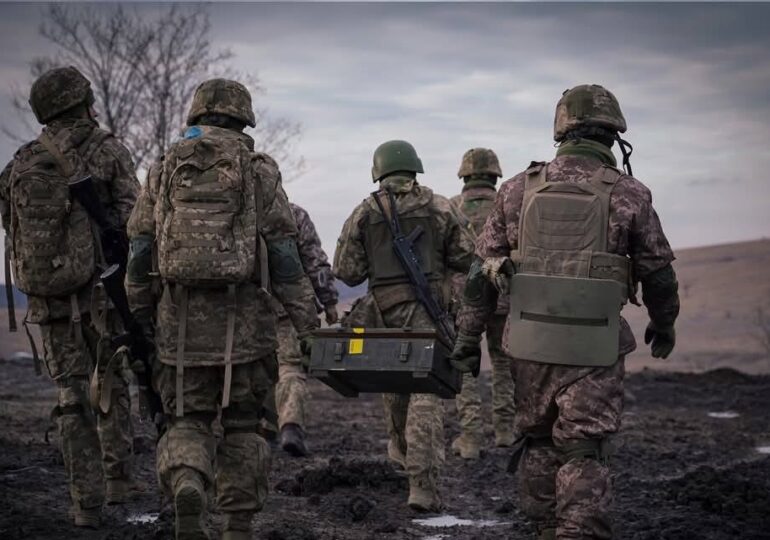Ukrainian soldiers fighting in the Kursk region of Russia describe living through scenes „like in a horror movie” as they retreated from the front line.
Ukrainian soldiers speak of a „catastrophic” retreat from the Kursk region due to intense enemy fire and constant attacks by swarms of Russian drones.
They were given false first names to protect their identities and say the front line has entered a "collapse" phase, with Ukraine losing Sudja, the largest settlement it held on Russian territory, reports BBC.
Drone after drone, endlessly
On March 9, "Volodimir" wrote that he was still in Sudja, where "panic and front line collapse" had set in.
"Ukrainian troops are trying to leave - columns of troops and equipment. Some of them are hit by Russian drones on the way. It's impossible to leave during the day," the soldier wrote.
The movement of troops, logistics, and equipment relied on a crucial route between Sudja and the Ukrainian region of Sumy.
Volodimir said it was possible to travel on that road which a month ago was relatively safe. By March 9, everything had come "under enemy fire control, there were non-stop drones." "In a minute, you can see two to three drones. There are many," he said.
"We have all the logistics here, on a single highway Sudja-Sumy. And everyone knew that (the Russians) would try to cut it off. But this was again a surprise for our command," added the soldier. Just before the Russians entered Sudja, Volodimir said Ukrainian forces were pressed from three sides.
The roads are full of wrecks
By March 11, Ukrainian forces were fighting to prevent the road from being cut, according to messages received by BBC on Telegram from "Maksim." "A few days ago, we were ordered to leave the defense lines in an organized retreat," he said, adding that Russia had gathered a significant force to retake the city, "including a large number of North Korean soldiers."
Military experts estimate that Russia has assembled a force of up to 70,000 soldiers to liberate Kursk, including around 12,000 North Koreans.
Russia has also sent its best drone units to the front and used kamikaze and FPV drone variants, "to take control of the fire over the main logistic routes." These included drones tethered to operators by fiber optic cables, impossible to jam with electronic interference.
As a result, the enemy managed to destroy dozens of equipment units, and the wreckage of destroyed vehicles "clogged supply routes."
Inches from death
In social media posts from March 11-12, a fourth soldier, "Dmytro," compared the retreat from the front line to a scene "from a horror movie": "The roads are full of hundreds of destroyed cars, armored vehicles, and ATVs. There are many wounded and dead."
Vehicles were often hunted by multiple drones, he said.
Dmytro described his own narrow escape when the vehicle he was traveling in got stuck. He and his fellow soldiers were trying to free the vehicle when they were targeted by another FPV drone. It missed the vehicle but injured one of his comrades. He said they had to hide in a forest for two hours before being rescued.
Many Ukrainian soldiers retreated on foot between 15 and 20 kilometers. The situation, he said, evolved from "difficult and critical" to "catastrophic."
In a message from March 14, Dmytro added: "Everything is over in the Kursk region… the operation failed."
He estimated that thousands of Ukrainian soldiers have died since the start of the offensive in Russia in August.
What the Russian offensive achieved
A fifth soldier appeared less gloomy about the situation of Ukrainian troops. On March 13, "Artem" sent a message on Telegram from a military hospital, where he was being treated for shrapnel wounds suffered in a drone attack.
Artem said he fought further west – near the village of Loknia, where Ukrainian forces put up a tight resistance and "fought like lions."
He believes the operation had some success. "It is important that so far the Armed Forces of Ukraine have created this buffer zone, thanks to which the Russians cannot enter Sumy," he said.
What is the current situation in Kursk
Chief Commander of the Ukrainian Armed Forces, General Oleksandr Sirskyi, insisted that Ukrainian forces have withdrawn to "more favorable positions," remain in Kursk, and will do so "as long as it is opportune and necessary."
He said Russia has suffered over 50,000 losses during the Ukrainian offensive in the region, including killed, wounded, or captured soldiers.
Additionally, Ukrainian Defense Minister Rustem Umerov stated last weekend that Ukrainian defense forces have redeployed to more advantageous defense positions in the Kursk region. He denied reports claiming that "thousands of Ukrainian soldiers have been encircled."
"This is a perpetuation of propaganda. But we will continue our active defense operations with some offensive actions against the flanks of the enemy's operational forces to prevent their invasion of our territory," Umerov stated.
However, the current situation is very different from that in August. Military analysts estimate that Ukrainian forces have lost two-thirds of the 1,000 square kilometers gained initially, as reported by the BBC.
Any hope that Ukraine will be able to negotiate with the Kursk territory for some of its territories occupied by Russia has significantly diminished.
Ukrainian President Volodymyr Zelensky said last week that the operation in Kursk achieved its goal, forcing Russia to withdraw troops from the east and relieve pressure on the Pokrovsk sector. But the cost is still unclear.
T.D.

